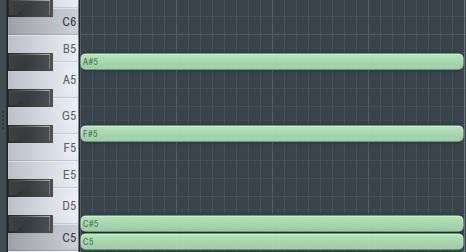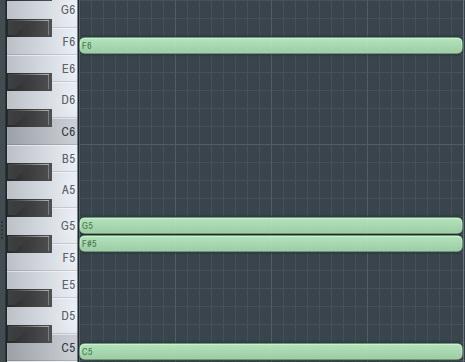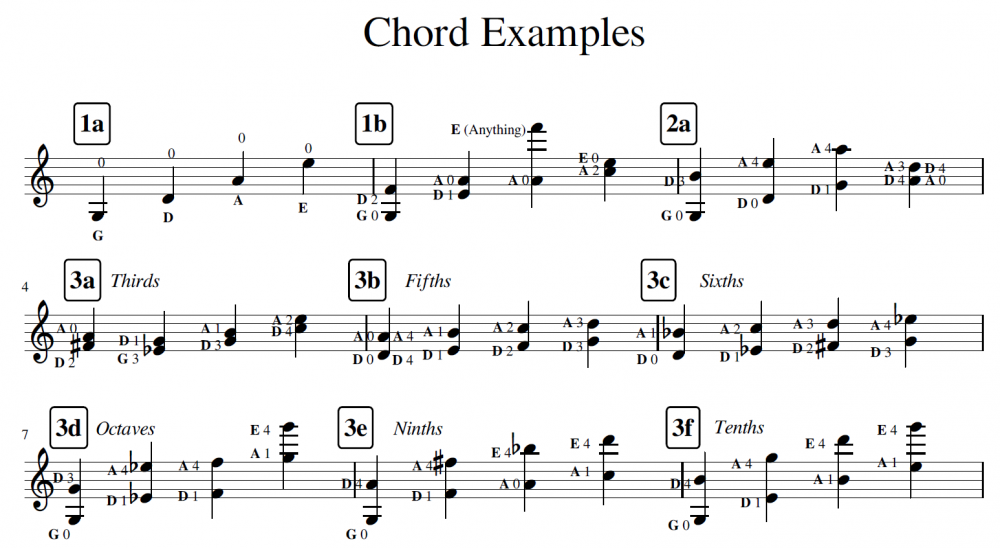Search the Community
Showing results for tags 'chord'.
-
Good hour good folks! This is a very very crucial question for me, so thank you in advance. I went ahead and tested the interval ranking (list of intervals from most consonant to dissonant in form of ratios) by building a chord with the 3 most dissonant intervals within the ranking which are Tritone - ratio (23:16) Minor 2nd - ratio (15:16) Minor 7th - ratio (9:16) Image Description (Root to tritone - root to minor 2nd - root to minor 7th.) As seen in the image above, according to the interval ranking there is no chord more dissonant than this. Now, the testing.. In the image above, if i were to take the Minor 7th interval (A#) and reposition it to the note (D), the chord will have now become significantly more dissonant than in it's original position. This would disprove that my use of the interval ranking was correct, as the chord is now more dissonant. Maybe.. i positioned the most dissonant intervals all relative to the root as opposed to placing them relative to the note below each successive interval, so lets visualize this updated structure below. Image Description (Root to tritone - tritone to minor 2nd - minor 2nd to minor 7th.) As seen in the image above, the intervals are now structured not relative to the root but by consecutive notes. Again, the testing.. In the image above, If i again, take the minor 7th (F) and reposition it to (G#), the chord is now more dissonant than in its original "supposedly max dissonance" chord structure shown above. ---------------------------------------------------------------------------------------------------------------------------------------------------------------------------- "Question Section" Question 1. In my second image example, did i utilize the interval ranking adequately? When stacking intervals, do you use intervals based off the note before the successor note or do you stack intervals all relative solely to the root? Question 2. In my second image example, i used the most dissonant intervals available within the interval ranking but yet when i shifted the minor 7th (F) and re-positioned it to (G#), the chord was more dissonant. So my 2nd approach to stacking intervals still doesn't prove to work effectively. What is the process behind this and how should intervals be stacked in a chord? Question 3. If we reference the second image and and focus on the F# and G notes right beside each other, they're pretty dissonant. If i push the G up or down an octave and leave the F# where it is, now they aren't as dissonant. Is the reason for this because when the two notes are beside each other in the same octave, their waves are both traveling at a similar rate but when one note is brought up an octave, because the frequency of that note has been doubled, now the two notes waves line up more as the higher octave note is now traveling twice as fast as the note an octave below? Question 4. If i stack intervals as explained in my second image example, which is by selecting my desired interval ratios relative to the note previous to it in my chord as opposed to the root, do the successive notes after my new note play a direct role "interval relationship wise" with the previous notes or does it just boil down to the note before the new note? Let me elaborate.. If i have C and E (Major 3rd) and then add a G on top of that, the C to E is a Major 3rd and the E to G is Minor 3rd. But in that chord structure the C to G could be considered a Perfect 5th and now the G is no longer a Minor 3rd interval within the chord. Which is right and which is wrong? Especially when more notes are added, the intervals can have multiple perspectives. So the questions boils down to, do we only focus intervals relative to the note before the new note added? If not, it would be a mess. Thank you very much guys!
-
It is often for composers to add chords in Violin repertoires to enrich the harmony and enhance the virtuosity. However, there are rules ought to be followed in composing to make the work playable. Here I would like to share some tips in chord writing for Violins. 1. Open String Chords It is important to know the 4 open strings of Violins: G, D, A, E. [Fig. 1a] Technically, it is almost always possible to play a chord with an open string and a note on neighbouring string(s). [Fig. 1b] 2. Substitutions It is possible to substitute a note, with its equivalent on a higher positions on a lower string, in order to avoid string crossing problems. For instance, in [Fig. 2a], the first chord is not playable if we choose to play the B note on the A string (A1, first position), as it will skip the D string. However, it is playable if we substitute A1 by D3 (3rd position), and now it is a chord with notes on 2 neighbouring strings, G and D. Such technique is particularly useful for 9th and 10th, which I will mention in latter sections. For the fourth chord, this time if we pick the A note as an open string note (A0), both notes will lay on the same string. Impossible. Therefore, to make it playable, we can either substitute A0 by D4 while keeping the A3, or substitute A3 by D(Anything) while keeping A0. 3. Common Practice for Intervals For 3rd's, we use 0-2, 1-3, 2-4 or 3-1 (or in the reversed order). [Fig. 3a] For (perfect) 5th's (or equivalently diminished 6th's), we use the same fingering for both notes. (i.e. 0-0, 1-1, ..., 4-4) [Fig. 3b] For 6th's, it is essentially a 5th with the upper note shifting higher. So the fingering is 0-1, 1-2, 2-3, 3-4. [Fig. 3c] For 8th's, the most common fingering is 0-3 (when it involves an open string) or 1-4. [Fig. 3d] For 9th's, it is essentially an octave with the upper note shifting higher. So the fingering is 0-3/0-4 (when it involves an open string) or 1-4 (stretching 4th finger!). [Fig. 3e] For 10th's, 1-4 (intensely stretching 4th finger!). [Fig. 3f] These are some fundamental rules for chord writings on Violins. Questions or example discussions are welcomed. HoYin
-
Hi everyone. This is a famous chord progression used in the chorus in pop songs, in the key of C major: F - G - Em - Am - Dm - G - C :|| However, there is a variation of this chord progression. After the repeat, the bass goes as: F# - F - E - Eb - D - G - C Can anyone figure out what are these chords? I'm assuming that they are: F#dim or F#m7-5 - Fm7 - C/E - Ebdim - Dm - G - C Here is an example of the chord progression: Thank you very much!
-
So, when I first started theory I was told that retrograde (movement from a dominant function chord to a pre-dominant function chord) was strictly forbidden in common practice harmony. However, while working through Hindemith's "Traditional Harmony" I found that several of Hindemith's prescribed progressions in the exercises have retrograde progressions. So, is retrograde strictly forbidden? Are there exceptions? Am I just stupid? Discuss.
- 13 replies
-
Hey everyone I have read from a few websites/books that it is a good idea to turn the "Vm" chord into a "V7" chord when you are working in a minor key, so that it points more strongly to the "I" chord. But wouldn't you then be out of key by changing the minor 3rd in the "V" chord into a major 3rd? I don't understand how this works as you would also have to change that note in the melody to avoid sound dissonant, or is that the whole idea? I was thinking maybe you should make that a permanent change for the key? So for example if you are writing in A minor, change the G to a G♯ and keep it that way for both the harmony and the melody? How does this whole idea work? Thanks for your help
-
Hey everyone, hope your all doing well. I want to go more in depth with chord voicing. I know about inversions and I use them to make help chord changes more fluid and avoid too much parallel harmony, but that's all I use them for. Are there other reasons one would choose a certain chord voicing? Is the middle not that important and it's all about the top and bottom notes? I would like to have a greater understanding and was wondering if anyone can recommend a book or something that goes into great detail and the subject? So far I have just been making it so each line moves as little as possible to the next note, without really understanding how the voicing can have an effect on the sound. Thanks for your time EDIT: I have just read this topic: http://forum.youngco...oicing-help-me/ Some good advice from Wayne-Scales Still would like some more information on it though






